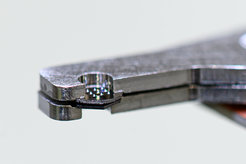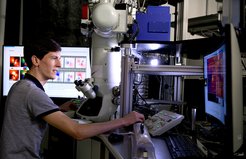World’s fastest electron microscope films light oscillations using quantum interference
A research team from Göttingen and Barcelona (Spain) has used the quantum mechanical interference of electrons to visualize light field oscillations in a nanostructure. The experiment is based on an attosecond electron microscope developed by Claus Ropers’ group at the Max Planck Institute (MPI) for Multidisciplinary Sciences and the University of Göttingen, which reveals the interaction of matter and light in the nanocosmos.

Light consists of incredibly fast oscillating electric and magnetic fields. However, our eyes and digital cameras only perceive the brightness and color of the light, i.e. the amplitude and frequency of the wave. However, many phenomena in nature and technology depend on the propagation and scattering of light on a microscopic scale far below the wavelength. These processes take place in the attosecond range, meaning within billionths of a billionth of a second. The 2023 Nobel Prize in Physics was awarded for, among other things, attosecond physics techniques. These can be used to investigate how the charges in atoms and molecules are set into oscillation by light in the alternation of wave crests and troughs.

Until now, however, there has been a lack of methods that combine these concepts with a high spatial resolution in order to map processes on atomic length scales. Researchers led by Claus Ropers have now succeeded in exploiting quantum mechanical effects to record precise films of the light fields on a nanoscopic structure. The team collaborated with Javier García de Abajo, Professor at the Institute of Photonic Sciences in Barcelona.
Electrons traveling through a light field in an electron microscope are deflected and change their speed. Due to quantum mechanics, however, there is an uncertainty as to whether the electron is accelerated or decelerated. This results in a complex superposition of different speeds – a quantum state. Scientists from the Department of Ultrafast Dynamics have now found a new way to read out all the intensity and time information stored in this quantum state and thus precisely measure the light field.
John Gaida, PhD student at the MPI, demonstrated this by “filming” the oscillations on a gold structure just 100 nanometers in size. As the structure is much smaller than the wavelength of the irradiated laser light, resonances occur at certain light frequencies, which are strongly influenced by the geometry of the nanostructure. In the experiment, the electron beam is scanned over the sample nanometer by nanometer in order to read out the light field with high accuracy at each position.

“To achieve the time resolution in the attosecond range, we transfer a technique from electronics and laser optics to electron beams. By mixing the signal with a reference in a controlled manner, we generate an interference pattern that encodes the light oscillation,” explains Gaida, first author of the study now published in the journal Nature Photonics.
“The developed instrument can be understood as an oscilloscope for optical frequencies, with a probe the size of a nanometer,” explains Ropers. “We have thus created a precision microscope to determine quantum states on the nanometer scale. In addition to measuring electromagnetic fields, this gives us access to a wide range of ultrafast processes in the nanocosmos.” (jhg)
The German Research Foundation (DFG) funded the work presented here as part of the DFG Collaborative Research Center 1456 “Mathematics of Experiment”.











